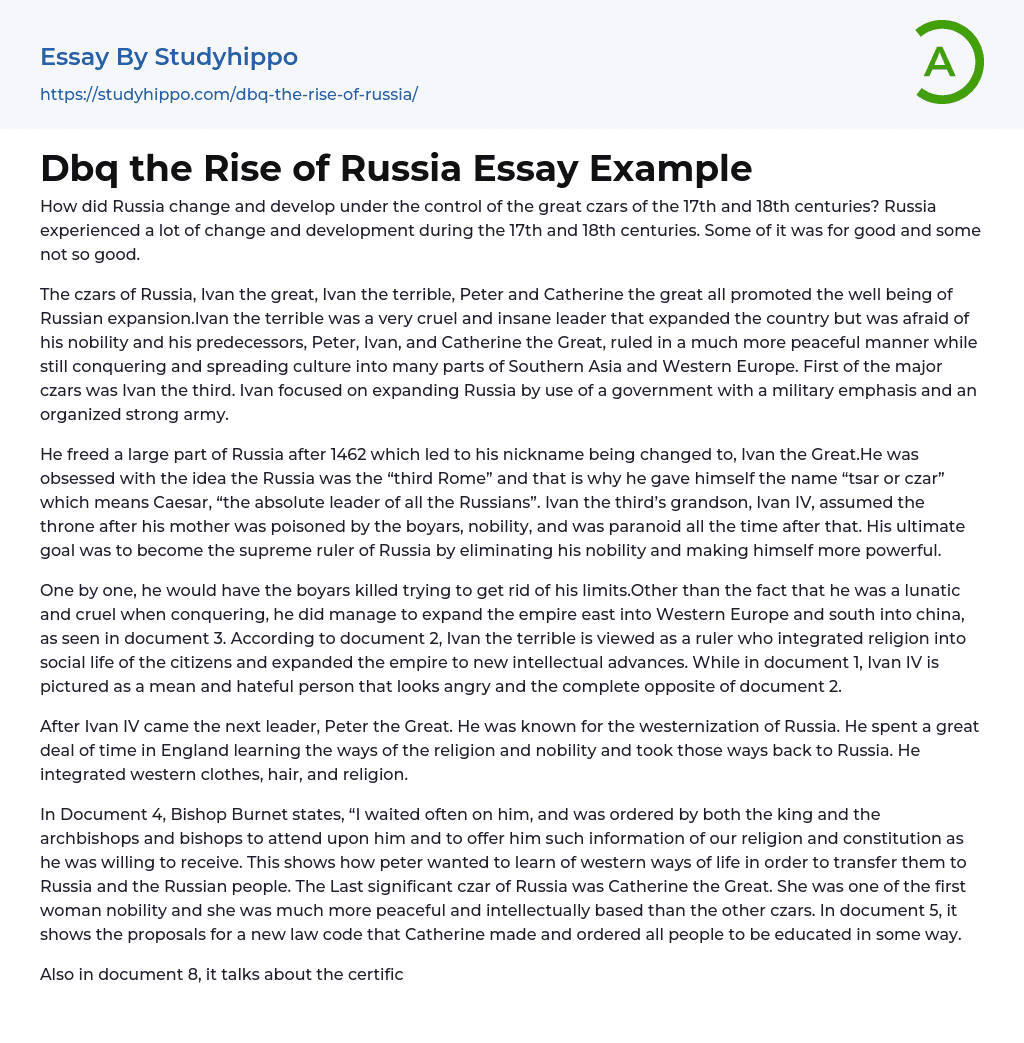How did Russia change and develop under the control of the great czars of the 17th and 18th centuries? Russia experienced a lot of change and development during the 17th and 18th centuries. Some of it was for good and some not so good.
The czars of Russia, Ivan the great, Ivan the terrible, Peter and Catherine the great all promoted the well being of Russian expansion.Ivan the terrible was a very cruel and insane leader that expanded the country but was afraid of his nobility and his predecessors, Peter, Ivan, and Catherine the Great, ruled in a much more peaceful manner while still conquering and spreading culture into many parts of Southern Asia and Western Europe. First of the major czars was Ivan the third. Ivan focused on expanding Russia by use of a government with
...a military emphasis and an organized strong army.
He freed a large part of Russia after 1462 which led to his nickname being changed to, Ivan the Great.He was obsessed with the idea the Russia was the “third Rome” and that is why he gave himself the name “tsar or czar” which means Caesar, “the absolute leader of all the Russians”. Ivan the third’s grandson, Ivan IV, assumed the throne after his mother was poisoned by the boyars, nobility, and was paranoid all the time after that. His ultimate goal was to become the supreme ruler of Russia by eliminating his nobility and making himself more powerful.
One by one, he would have the boyars killed trying to get rid of his limits.Other than the fact that he was a lunatic and cruel when conquering, he did manag
to expand the empire east into Western Europe and south into china, as seen in document 3. According to document 2, Ivan the terrible is viewed as a ruler who integrated religion into social life of the citizens and expanded the empire to new intellectual advances. While in document 1, Ivan IV is pictured as a mean and hateful person that looks angry and the complete opposite of document 2.
After Ivan IV came the next leader, Peter the Great. He was known for the westernization of Russia. He spent a great deal of time in England learning the ways of the religion and nobility and took those ways back to Russia. He integrated western clothes, hair, and religion.
In Document 4, Bishop Burnet states, “I waited often on him, and was ordered by both the king and the archbishops and bishops to attend upon him and to offer him such information of our religion and constitution as he was willing to receive. This shows how peter wanted to learn of western ways of life in order to transfer them to Russia and the Russian people. The Last significant czar of Russia was Catherine the Great. She was one of the first woman nobility and she was much more peaceful and intellectually based than the other czars. In document 5, it shows the proposals for a new law code that Catherine made and ordered all people to be educated in some way.
Also in document 8, it talks about the certification that boys between the age of 10 and 15 must have in order to marry and get a job.Catherine wasn’t all about peace though. She
took matters into her hands when the emelian pugachev sparked a peasant rebellion that threatened catherine’s place at the throne. She quickly put down the rebellion and stood strong until her death in 1796.
She was one of the most fascinating woman leaders in history due to her strong leadership and ability to take control of her large empire. The czars of Russia all promoted the growth and development in Russia. But, their tactics to achieving their ultimate goals were all completely different.Ivan IV was a cruel and insane leader, whereas Ivan III, Peter, and Catherine were all very peaceful and took control of their empires in a good way. The czars of Russia, Ivan the great, Ivan the terrible, Peter and Catherine the great all promoted the well being of Russian expansion. Ivan the terrible was a very cruel and insane leader that expanded the country but was afraid of his nobility and his predecessors, Peter, Ivan, and Catherine the Great, ruled in a much more peaceful manner while still conquering and spreading culture into many parts of Southern Asia and Western Europe.
- Baptism essays
- Holy Spirit essays
- Jesus Christ essays
- Adam And Eve essays
- Crucifixion Of Jesus essays
- Crusades essays
- Eucharist essays
- God The Father essays
- Pope essays
- Protestantism essays
- Christian essays
- Church essays
- Elizabeth essays
- Sacrament essays
- Catholic Church essays
- Lord essays
- Priest essays
- Protestant Reformation essays
- Afterlife essays
- Atheism essays
- Bible essays
- Buddhism essays
- Christian Worldview essays
- Christianity essays
- Confession essays
- Cosmological Argument essays
- Deism essays
- Devil essays
- Existence of God essays
- Faith essays
- Freedom Of Religion essays
- God essays
- Hinduism essays
- Immortality essays
- Islam essays
- Jainism essays
- Jews essays
- Judaism essays
- Miracle essays
- Monk essays
- Monotheism essays
- New Testament essays
- Old Testament essays
- Pilgrimage essays
- Puritans essays
- Revelation essays
- Ritual essays
- Salvation essays
- Sin essays
- Sinners essays




